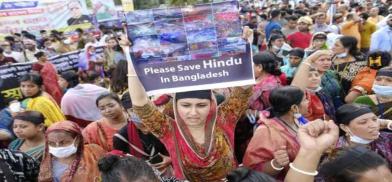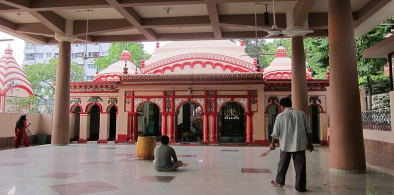Are Hindus being persecuted in Bangladesh? Facts belie prevailing narratives
Unlike Myanmar and India, Bangladesh has never, particularly since 1991, promoted any discriminatory policy against minorities, writes Samina Akhter for South Asia Monitor

It is said that no Hindus will be left in Bangladesh in the next 30 years if the current rate of exodus continues. Is this true?
Such an understanding is incorrect. Bangladesh is being depicted unfairly and without evidence as a country that discriminates against its minorities, particularly Hindus.
There is no doubt that Bangladesh has seen a steady outflow of Hindus since the 1947 partition of the sub-continent. Minorities accounted for 23.1 percent of the population in 1951, but only 9.6 percent in 2011.
A recently published book has predicted that there will be no Hindus left in Bangladesh in the next 30 years if the current rate of exodus continues.
Distorting facts
According to the book, 11.3 million Hindus were either forced to leave the country or migrated between 1964 and 2013. The author of the book said the rate of exodus over the last 49 years paints a grim picture for the Hindu minority in Bangladesh where their population remains just 8.2 percent, according to the last census.
The author has failed to depict the real scenario. For example, Priya Saha, a Hindu rights activist, participated in the Second Ministerial to Advance Religious Freedom at the US Department of State in Washington in July 2019. In a video clip that went viral, Saha was heard telling Trump: "Sir, I'm from Bangladesh ... 37 million Hindus, Buddhists and Christians have disappeared. Please help us… We want to stay in our country.“
In a video message, Saha tried to defend her remarks. She was accused of distorting facts when she interacted with Trump.
On the other hand, during communal violence in Bangladesh against Hindu minorities in 2021, numerous criticisms were brought to light. Some claimed that Bangladesh has become a case of ethnic cleansing, subtly ousting Hindu minorities across the border. Some even claimed that in Bangladesh different religious and ethnic groups cannot coexist although secularism was one of the four pillars of the 1971 liberation war.
Slower Hindu growth
According to the Bangladesh Bureau of Statistics, the percentage of Hindu community to total population was 13.5 percent in 1974, on Bangladesh’s first population census. In 2011, this stood at 8.5 percent and increased to 10.7 percent in 2015.
But mere percentage estimation tells only the half the truth about the broader demographic landscape. If we take the increase in total number, other than mere percentage, it will substantially clarify the whole picture and weaken the prevailing narratives about the persecution of Hindus in Bangladesh.
Taking the total number into account, in 1974, the Hindu population totalled 10.31 million, which hit slightly above 12.7 million in 2011 and 17 million in 2015. It is seen that the total number has remained increasing whereas percentage to total Muslim population, due to relatively higher growth in the number of Muslims from 65.24 million in 1974 to 135.4 million in 2011, has kept decreasing.
It is true that growth in numbers is a little slow among Hindu population. It can touch 22 million only if it increased linearly in terms of percentage as reported in 1974 (13.5 percent). But that is not because of any systematic persecution against the minority rather, in most part, due to international economic migration, relatively lower birth and high mortality rate among Hindu population, higher rate of contraceptive use and the particular political reality in Bangladesh.
Countervailing evidence
According to the study paper prepared by researchers from ICDDR,B’s Health Systems and Population Studies Division and the University of North Carolina (Chapel Hill), studying the population data of 1989-2016 of Matlab Upazila in Chadpur to find out why Hindus have lower population growth than Muslims, the birth rate of Hindu populace in every thousand falls short by 3 points comparing to Muslims.
The study found that the tendency to late marriage and having not more than two children and relatively higher use of contraceptives also contribute to the low birth rate among Hindu populace. Even higher numbers of deaths, four more than that of Muslims in every 10,000, can also be ascribed to the decrease in percentage. Finally, researchers concluded that 71 percent of low growth rate may be attributed to the low rates of fertility and 23 percent to the international out-migration by Hindus.
In the report, they observed that, since 2006, more Hindus have been opting for countries other than India for out-migration. Only 36 percent of the migrating Hindus of Matlab went to India between 2005 and 2012, but the bigger portion of them went to countries other than India for better living -- a countervailing evidence against the predominant propaganda that more Hindus have been leaving for India due to persecution.
No discriminatory policy
To be true, the percentage of Hindu minority compared to Muslims has declined over the last 50 years. But this estimation has overlooked a subtle but solid point: a fundamental political upheaval and constitution of Bangladesh from 1975 to 1991. From 1974 to 1991, the percentage of Hindu minority to total population came down from 13.5 percent to 10.5 percent in 16 years.
But after the end of anti-secularism fueled military rule in 1991 and installation of constitutional democracy, the percentage decline got a little slower -- 10.5 percent in 1991 to 8.5 percent in 2011 within 20 years. In 2011, after the 15th amendment of the Bangladesh Constitution, there has been an increase of Hindu people to total populace to 10.7 percent point in 2015.
Unlike its two bordering states Myanmar and India, the Bangladesh state has never, particularly since 1991, promoted any discriminatory policy, be it in practice or by law.
Every country has a minority, be it ethnic or linguistic or religious. But state sanctioned discriminatory policy, inherent ethnic or religious tension or historical schism mobilized for political scoring usually contribute to violence against minorities.
However, in Bangladesh, the mostly politically cornered vested groups have played on minority issues to stoke a crisis to their end.
(The author is a Dhaka-based woman and human rights activist. Views are personal. She can be contacted at saminaakhter1709@gmail.com)















Post a Comment